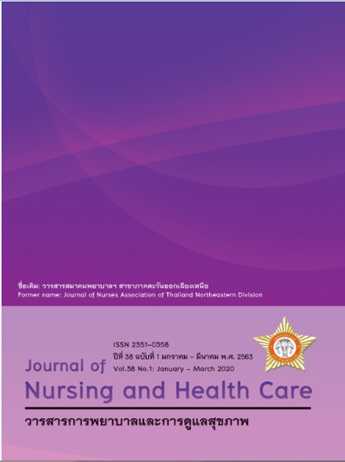การพัฒนาหนังสือด้วยเทคโนโลยีภาพเสมือนจริง เพื่อส่งเสริมการทำกิจกรรมกระตุ้นการดูดกลืนแก่ทารกที่มีภาวะปากแหว่งเพดานโหว่
คำสำคัญ:
AR book, Breast feeding, Cleft lip and palateบทคัดย่อ
การวิจัยครั้งนี้เป็นการวิจัยกึ่งทดลอง แบบมีสองกลุ่มเปรียบเทียบ มีวัตถุประสงค์เพื่อพัฒนาหนังสือด้วยเทคโนโลยีภาพเสมือนจริง เพื่อส่งเสริมการทำกิจกรรมกระตุ้นการดูดกลืนแก่ทารกที่มีภาวะปากแหว่งเพดานโหว่ สำหรับมารดาที่มีบุตรปากแหว่งเพดานโหว่ ทำการเก็บข้อมูล ณ หอผู้ป่วย 2ข หอผู้ป่วย 3ค โรงพยาบาลศรีนครินทร์ และศูนย์ตะวันฉาย คณะแพทยศาสตร์ มหาวิทยาลัยขอนแก่น ช่วงเดือนมีนาคม ถึงกรกฎาคม 2562 กลุ่มตัวอย่างเป็นมารดาหลังคลอด อายุระหว่าง 20-45 ปี ที่มีบุตรปากแหว่งเพดานโหว่ อายุ 7 วัน ขึ้นไป จนถึงอายุ 6 เดือน โดยรายงานวิจัยฉบับนี้เป็นส่วนของขั้นตอนการพัฒนาเครื่องมือที่ในการทดลองในการวิจัยครั้งนี้คือ หนังสือคู่มือการส่งเสริมการทำกิจกรรมกระตุ้นการดูดกลืนสำหรับทารกปากแหว่งเพดานโหว่ ด้วยเทคโนโลยีภาพเสมือนจริง ซึ่งเป็นการบูรณาการเทคโนโลยีการศึกษาเพื่อมาเสริมสร้างความรู้ ความเข้าใจ และส่งเสริมทักษะความมั่นใจในการกระตุ้นการดูดกลืนของทารกโดยมารดาที่ผ่านการฝึกการใช้คู่มือ ขั้นตอนในการพัฒนาหนังสือด้วยเทคโนโลยีภาพเสมือนจริง เพื่อส่งเสริมการทำกิจกรรมกระตุ้นการดูดกลืนแก่ทารกที่มีภาวะปากแหว่งเพดานโหว่ประกอบด้วยการทบทวนวรรณกรรมที่เกี่ยวข้องกับการกระตุ้นการดูดกลืน ในทารกที่มีภาวะปากแหว่งเพดานโหว่ การในนมบุตร และการประเมินความพร้อมในการดุดกลืน ขั้นตอนการพัฒนาหนังสือ เริ่มจากผู้วิจัยได้ผ่านการฝึกอบรมการพัฒนาสื่อการสอนในหลักสูตร Mobile based learning และผ่านการพัฒนาและให้ข้อเสนอแนะโดยผู้ทรงคุณวุฒิ สรุปประเด็นที่นำไปสู่การพัฒนาสู่การทดลองการวิจัยต่อไป
Downloads
เอกสารอ้างอิง
1. Amstalden-Mendes LG, Magna LA, Gil-da-Silva-Lopez VL. Neonatal care of infants with cleft lip and/or palate: feeding orientation and evolution of weight gain in non-specialized Brazilian Hospital. Cleft palate-craniofacial journal 2007; 44(3): 329-334.
2. Burca NDN, Gephart SM, Miller C & Cote C. Promoting breast milk nutrition on infants with cleft lip and/or palate. Advances in neonatal care 2016; 16(5): 337-344.
3. Chowchuen B, Prathanee B & Pradubwong S, editors. A guide handbook for parents and cares patients with cleft lip and palate. Khon Kaen : Center of Cleft lip-Cleft palate and Craniofacial Deformities, Khoon Kaen university in association with the Tawanchai Project Faculty of Medicin Khon Kaen University: 2013.
4. Mizuno K, Ueda A, Kani K & Kawamura H. Feeding behavior of onfants with cleft lip and palate. Acta peadiatr 2002; 91, 1227-1232.
5. Noyudom A & Wongwatkit C. Effectiveness of interactive mobile application instruction on students’ knowledge on eye cleaning. Journal of nursing health care 2018; 36(2): 132-180.
6. Prathanee B. Cleft lip and palate: Speech problem and multidisciplinary management vol.1. Khon Kaen: Academic and Information Technology Department Institute of Learning and Teaching Innovation Khon Kaen University; 2014.
7. Ried J, Reilly S & Klipatrick N. Sucking performance of babies with cleft condition. The cleft palate- craniofacial journal 2007; 44(3): 312-320.
8. Sangkaew R, Piyasuwan S & Poopang J. “Child optimal growth” perception of meaning and feeding practice of caregiver-child 0-5 years. Journal of nursing health care 2019; 37(2): 123-132.
9. Srisoparb W, Yudee P, Prompan O, Chaemsakun A, Meesuwan W. The development of augmented reality supplement book “device in spinal cord injury patient ambulation”. Journal of education Naresuan University 2013: 15; 24-32.
10. Theerasopon P, Pathumwiwatana P. The development of nursing roles in promoting breast feeding for babies with cleft lip and palate. Journal of nursing science & health 2011; 34:1-8.
11. Treenon P, Teanthong S. Boonlom T, Wanchai C, Boonbanjong C, Pontep Y, Panpeng N, Pakwan N, Pruethong N, Phetkeaw D, Pholsa D. High school students knowledge and skill about basic life support (BLS): the effect of using an application. Journal of nursing health care 2019; 37(3): 98-105.



